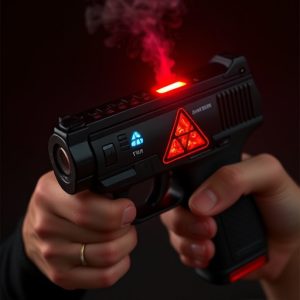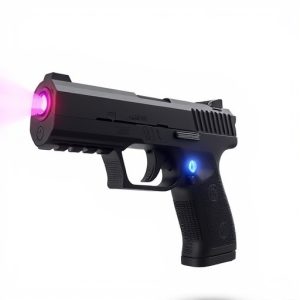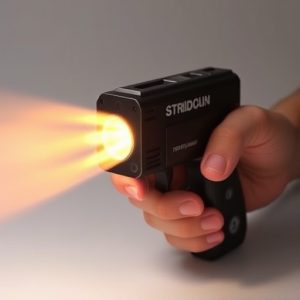Triad Stun Gun Ratings: Understanding Stopping Power and Selection
Stun gun stopping power ratings, measured in joules or voltage, determine their effectiveness. The t…….
Stun gun stopping power ratings, measured in joules or voltage, determine their effectiveness. The triad stun gun excels due to its combination of current output, pulse width, and delivery mechanism. Key performance factors include electrical output, design quality, range, and contact configuration. Laboratory tests and field trials assess its capabilities, with the best stun guns delivering a powerful jolt (in MJ or voltage) for disabling attackers. The triad stun gun's versatile firing modes and additional features make it a popular choice for self-defense.
“Uncover the truth behind triad stun guns and their stopping power ratings in this comprehensive guide. Understanding the factors influencing performance is key to choosing the right self-defense tool. From testing methods to individual needs, we demystify what makes a stun gun effective. Learn how various elements impact voltage, current, and delivery systems, enabling you to make an informed decision. Discover the nuances of triad stun guns and gain the knowledge to ensure your safety.”
- Understanding Stun Gun Stopping Power Ratings
- Factors Affecting Triad Stun Gun Performance
- Evaluating Different Testing Methods
- Choosing the Right Stun Gun for Your Needs
Understanding Stun Gun Stopping Power Ratings
Stun gun stopping power ratings are a crucial metric for understanding the effectiveness of self-defense devices. These ratings measure the strength of an electrical shock delivered by a stun gun, typically expressed in joules or voltage. The higher the rating, the more powerful the stun, which can significantly increase the likelihood of disabling an assailant.
When evaluating stun guns, it’s essential to consider the triad stun gun—a category that encompasses key factors such as current output, pulse width, and delivery mechanism. Current output refers to the amperage of the shock, while pulse width determines the duration of the electrical impulse. Together, these elements contribute to the overall stopping power, ensuring users have a reliable tool for self-defense in various threatening situations.
Factors Affecting Triad Stun Gun Performance
The performance of a triad stun gun, like any other self-defense tool, is influenced by several key factors. First and foremost, the electrical output is a primary indicator of its stopping power. Higher voltage and current can swiftly incapacitate an assailant, making it a crucial metric for users looking to deter attacks effectively. The design and quality of the stun gun play a significant role as well; a well-engineered triad stun gun with robust materials will ensure consistent performance over time, even in demanding conditions.
Additionally, the range and contact configuration are essential aspects that affect its practicality. A longer reach allows for safer engagement, especially in self-defense scenarios where distance can be an important factor. Meanwhile, the ease of deployment and reliability in making direct contact with the target are critical to the stun gun’s overall effectiveness, as a user’s ability to quickly and accurately deploy it can mean the difference between a successful intervention and an unfortunate outcome.
Evaluating Different Testing Methods
The evaluation of a triad stun gun’s stopping power involves diverse testing methods, each offering unique insights into its effectiveness. Laboratory tests often employ controlled settings to measure the device’s impact on simulated targets, providing numerical data on shock delivery and muscle disruption. These results offer a standardized comparison between various stun guns.
However, real-world scenarios demand a different approach. Field testing involves subjecting the triad stun gun to practical conditions, such as hand-to-hand combat or self-defense situations. Observational studies record its impact on potential attackers, offering anecdotal evidence of its stopping power and effectiveness in real-life applications. This dual approach ensures a comprehensive understanding of the triad stun gun’s capabilities.
Choosing the Right Stun Gun for Your Needs
When choosing a stun gun, understanding stopping power ratings is crucial for ensuring your safety. The right stun gun should deliver a powerful enough jolt to incapacitate an attacker temporarily, giving you time to escape. Ratings typically measure the electrical output in millijoules (MJ) and voltage levels. Higher numbers indicate greater stopping power.
One popular option gaining traction among users is the triad stun gun. This model offers multiple firing modes, including a stun mode with a high stop-power rating, making it versatile for various situations. A triad stun gun’s ability to deploy a powerful shock while also featuring other useful functions like LED lighting or an alarm can be invaluable in self-defense scenarios.
When selecting a triad stun gun, understanding stopping power ratings, the influencing factors, and adopting credible testing methods are pivotal. By evaluating these aspects, you can make an informed decision that aligns with your specific needs. Remember, the right stun gun should offer reliable protection without compromising safety or usability.


